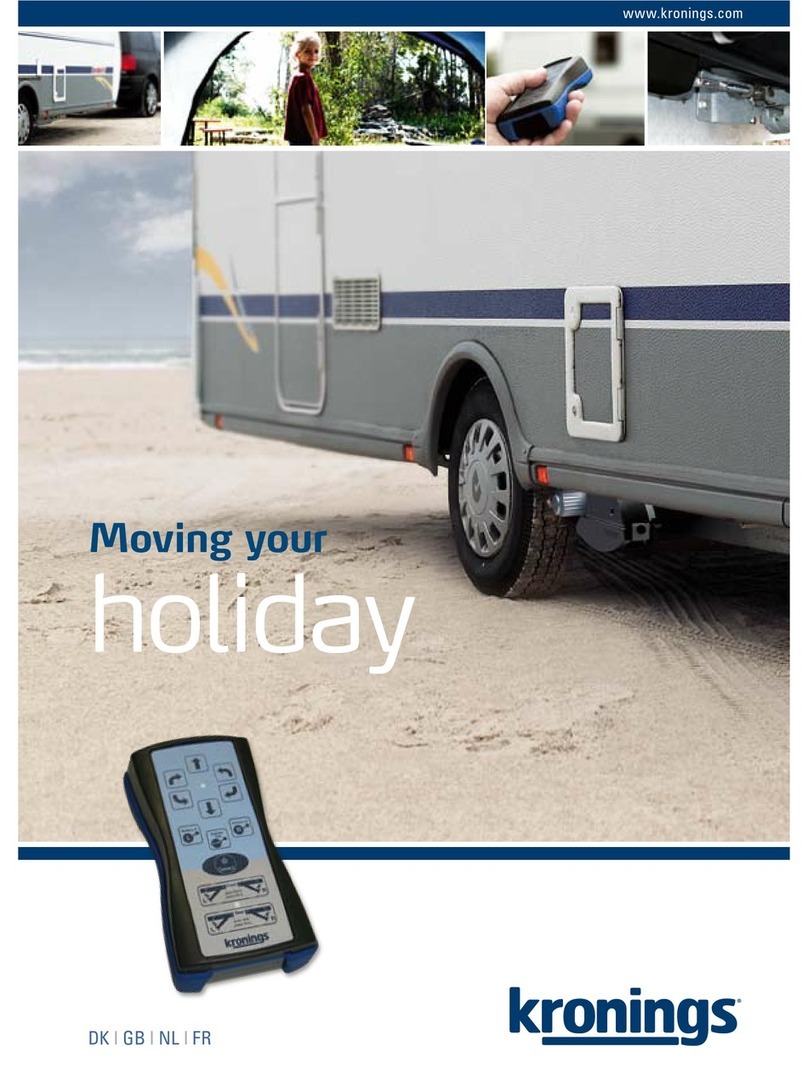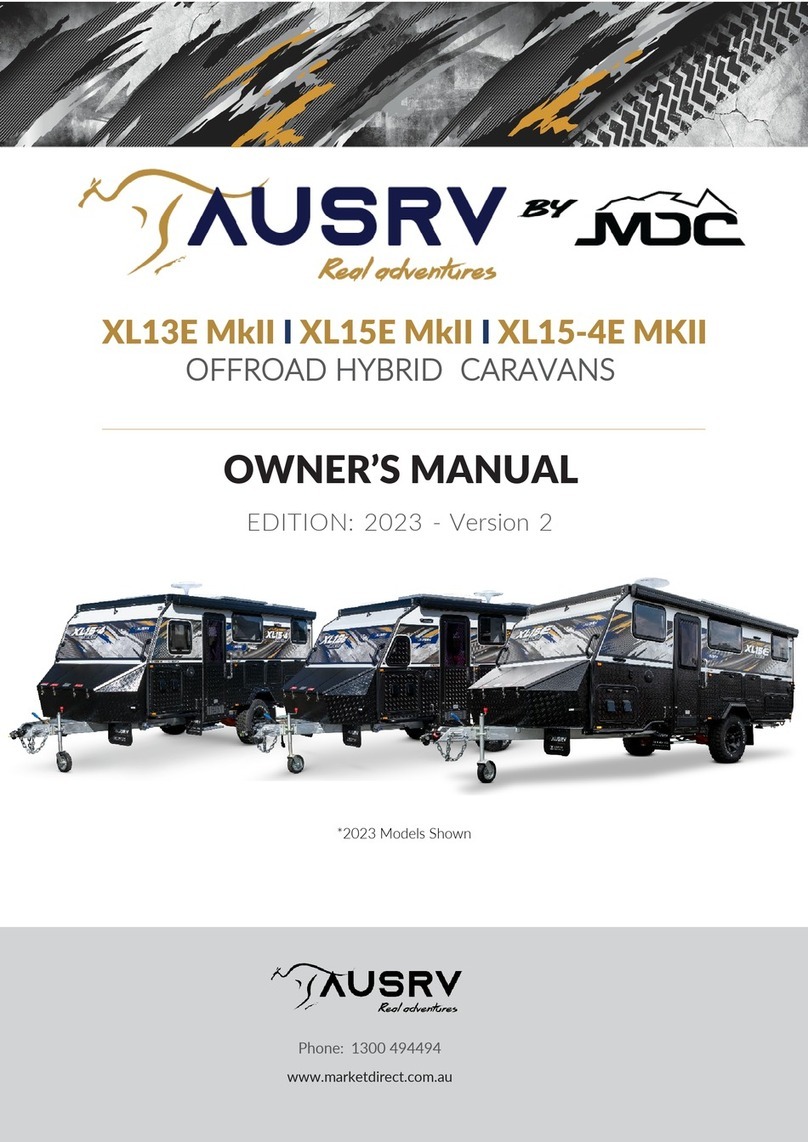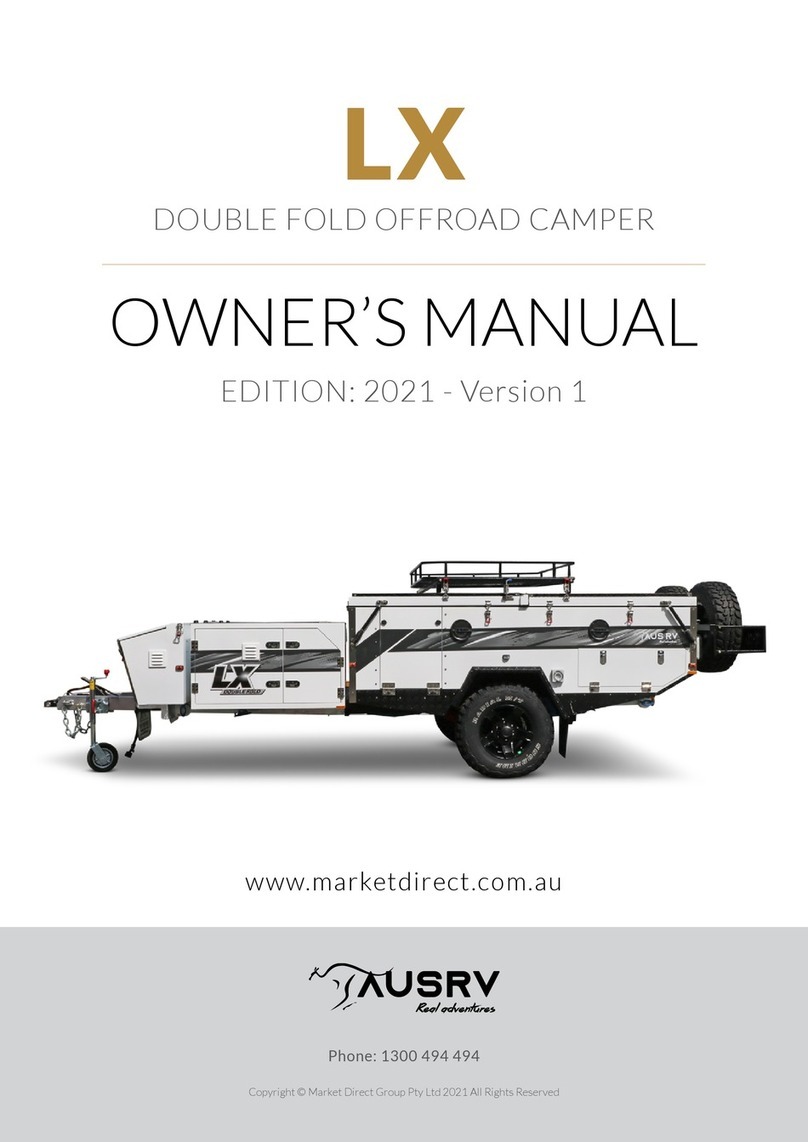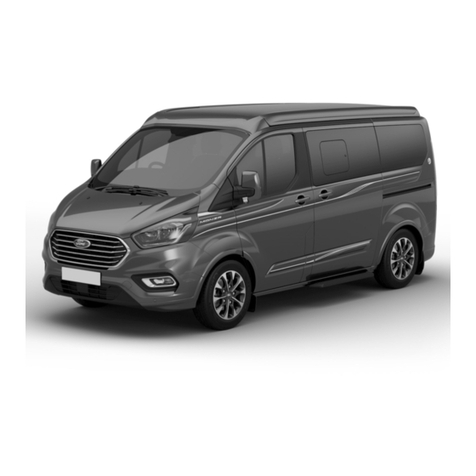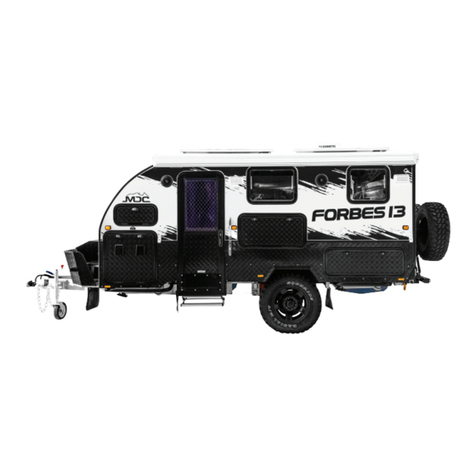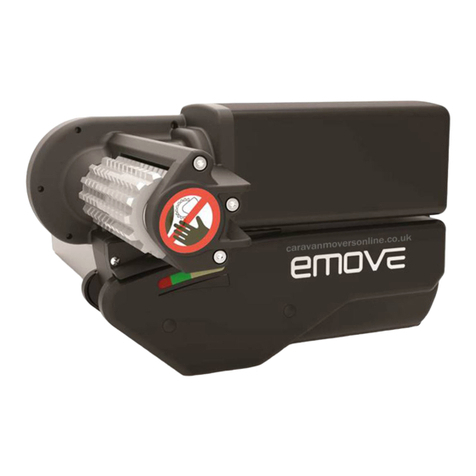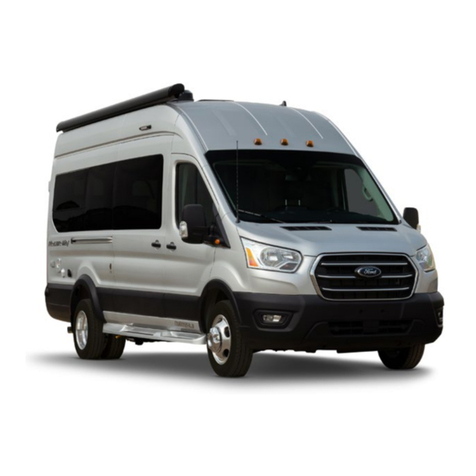kronings HERO CAMPER User manual

HERO CAMPER TRAILER MANUAL –2021
Disclaimer and Copyright
All information, illustrations and specifications contained in this manual are based onthe
latest product information available at the time of publication approval. When new
materials and production techniques are developed that can improve the quality of its
product, or material substitutions are necessary due to availability, Hero Camper Trailer
reserves the right to make such changes.
HEROCAMPERTRAILEROwner’sManual
Hero Camper

Contents
INTRODUCTION................................................................................................................................................1
Safety ...........................................................................................................................................................1
Safety Precautions ...................................................................................................................................1
Mold.........................................................................................................................................................1
Tire Safety ................................................................................................................................................2
Lug Nut Torqueing....................................................................................................................................2
Towing and Weight Distribution ..............................................................................................................2
Control Sway ............................................................................................................................................2
GENERAL INFORMATION .................................................................................................................................2
Coverage Provided.......................................................................................................................................3
Owner’s Obligation ......................................................................................................................................4
Warranty......................................................................................................................................................4
Limited Warranty .....................................................................................................................................4
Warranty Exclusions.................................................................................................................................4
What Is Not Covered................................................................................................................................4
Reporting Safety Defects..........................................................................................................................6
CAMPING..........................................................................................................................................................7
Overnight Stop .............................................................................................................................................8
Extended Stay ..............................................................................................................................................9
Leveling ........................................................................................................................................................9
Support legs .................................................................................................................................................9
Effects of Prolonged Occupancy ..................................................................................................................9
Tips to Controlling Condensation...............................................................................................................10
Molds .....................................................................................................................................................10
Contributing Factors to Mold Growth....................................................................................................10
Inhibiting Mold Growth..........................................................................................................................11
Safety .........................................................................................................................................................11
INTERIOR........................................................................................................................................................12
General Information and Cleaning.............................................................................................................12
Water tank .................................................................................................................................................12
EXTERIOR........................................................................................................................................................13

General Information and Operation ..........................................................................................................13
Doors......................................................................................................................................................13
Rear Door ...............................................................................................................................................13
Towing........................................................................................................................................................13
Tow Vehicle............................................................................................................................................13
Loading...................................................................................................................................................14
Towing Tips and Information ....................................................................................................................14
Off-Road Towing ....................................................................................................................................15
When Being Passed................................................................................................................................15
Passing....................................................................................................................................................15
Backing Up..............................................................................................................................................15
Controlling Sway or Fishtailing...............................................................................................................15
Equipment..............................................................................................................................................16
Driving....................................................................................................................................................16
Corrective Measures..............................................................................................................................16
MAINTENANCE...............................................................................................................................................18
Maintenance Schedule...............................................................................................................................18
Maintenance / Repair Schedule.................................................................................................................19
Tire Load and Inflation Information...........................................................................................................20
Proper Tire Inflation...............................................................................................................................20
Underinflated Tires ................................................................................................................................21
How Overloading Affects Your Tires ......................................................................................................21
Tire Care.................................................................................................................................................21
Tire Care Tips..........................................................................................................................................22
Lug Nut Torqueing......................................................................................................................................22
Spare Tire Carrier .......................................................................................................................................23
Brakes.........................................................................................................................................................23
Battery Storage ..........................................................................................................................................23
WINTERIZING AND STORAGE.........................................................................................................................24

1
Kronings® –Lammefjordsvej 5 –6715 Esbjerg N –Denmark
Phone +45 7022 5840 –sales@kronings.com
VAT No DK -40193189
INTRODUCTION
The Owner’s Manual for your new HERO trailer is designed to respond to the most frequent inquiries
regarding the operation, function, and care of the many systems that make modern trailering a joy.
Any modification done by the end user, will mean that the manufacturer can no longer guarantee the safety
nor is the warranty no longer applicable, for those areas and the once that the modification is related to. We
have provided many important safety messages in this manual. Always read and obey all safety messages.
DANGER: indicates an imminently
hazardous situation which, if not avoided,
will result in death or serious injury.
WARNING: indicates a potentially
hazardous situation which, if not avoided,
could result in death or serious injury.
CAUTION: indicates a potentially
hazardous situation which, if not avoided,
may result in minor or moderate injury. It
may also be used to alert against unsafe
practices.
NOTICE: is used to address practices not
related to personal injury. This applies to
hazardous situations involving property
damage only.
Optional items may be available on all our models. Additionally, some optional items can only be included
during the manufacturing phase and cannot later be added to the trailer.
The inclusion of optional items information in this manual does not imply or suggest the availability,
application suitability, or inclusion for any specific unit.
Safety
Safety Precautions
Many things can be construed as safety related, but the most important is your common sense. If you are
careless with matches, cigarettes, flammable material, or any other hazardous material, you surely realize
your potential for accidents is greatly increased.
You will find many safety recommendations in this section and throughout the manual. The following
recommendations are the ones we consider to be the most important.
Mold
Mold and mold spores exist throughout indoor and outdoor environments. There is no practical way to
eliminate all mold and mold spores in the outdoor environment, however, the way to control indoor mold
growth is to control moisture, by ventilating the units as much as possible.

2
Kronings® –Lammefjordsvej 5 –6715 Esbjerg N –Denmark
Phone +45 7022 5840 –sales@kronings.com
VAT No DK -40193189
Tire Safety
Properly maintained tires improve stopping, traction, and load-carrying capability of your vehicle. Refer to
page 27 - Maintenance for tire care and safety information. Also, be sure to read the Tire Safety Manual
Addendum included with your owner’s packet.
Lug Nut Torqueing
Making sure lug nuts on trailer wheels are tight and properly torqued is an important responsibility that
trailer owners and users need to understand and practice. Inadequate and/or inappropriate wheel nut
torque (tightness) is a major cause of lug nuts loosening in service. Loose lug nuts can rapidly lead to a wheel
separation resulting in potentially serious safety consequences. See torque pattern on page 22.
Towing and Weight Distribution
Weight distribution is an important factor when loading your travel trailer. A camper with the cargo
distributed properly will result in efficient, trouble-free towing. Refer to page 16 - Towing for more
information.
Control Sway
Sway or fishtailing is the sideways action of a trailer caused by external forces. Excessive sway of your
trailer can lead to the rollover of the trailer and tow vehicle, resulting in serious injury or death. Refer to
page 23 - Towing for more information.
GENERAL INFORMATION
Welcome to the Hero Camper Trailer family and thank you for selecting a Hero Camper Trailer product.
Congratulations on choosing a lifestyle that will provide you the freedom to enjoy recreation, wherever you
may choose.
This Owner’s Manual is designed as a Quick Reference Guide for the operation and care of your new
purchase. For more complete instructions regarding safety, maintenance and operation of the items used in
the manufacturing of your Hero Camper Trailer, carefully read the booklets supplied by the component
manufacturers. All information contained in this manual may not relate to your specific model; however,
booklets supplied by the component manufacturers and included in your Owner’s packet will provide any
additional information needed.
Your dealership personnel should be able to answer any questions or concerns you may have regarding your
new product. Please carefully read the Limited Warranty in this manual. Hero Camper Trailer has no other
expressed or implied warranties of any type. You, as the owner, are responsible for providing proper
maintenance as outlined in the manual and as set forth in the component manufacturer’s booklets.

3
Kronings® –Lammefjordsvej 5 –6715 Esbjerg N –Denmark
Phone +45 7022 5840 –sales@kronings.com
VAT No DK -40193189
NOTICE: Failure to properly maintain your
trailer could result in los of warranty
coverage.
Several of our component manufacturers carry their own warranties and require separate warranty
information to be filed with them. Please read all component manufacturers’ owner’s manuals provided
with your Hero Camper Trailer and file appropriate individual warranty cards as required. You have joined
the HERO family, and as you begin making great memories using your new Hero Camper, we wish you a lot
of exciting and adventurous days of camping.
Coverage Provided
Within the Warranty Period, Hero Camper Trailer is obligated to repair or replace any part covered by this
warranty proven defective. In the event of such an occurrence, the Owner should contact the selling
dealership for a service appointment. If it is not possible to return to the selling dealership, contact the Hero
Camper Trailer head office, and they will provide you with the location of the nearest authorized dealer or
repair facility.
The cost of transporting the Camper to the dealer or service center shall be incurred and paid for by the
Owner.

4
Kronings® –Lammefjordsvej 5 –6715 Esbjerg N –Denmark
Phone +45 7022 5840 –sales@kronings.com
VAT No DK -40193189
Owner’s Obligation
The purchaser must notify Hero Camper Trailer or a Hero Camper Trailer authorized dealer of any
defect promptly upon discovery. Warranty repairs by a non- Hero Camper Trailer Dealer or service
center must be approved by Hero Camper Trailer customer service prior to any work being started.
This is the only warranty given with the purchase of the Hero Camper Trailer other than express or
implied warranties given by the component manufacturers. Any warranties implied by law are
limited to the Warranty Period. Any other warranty, expressed or implied, not provided for in this
Limited Warranty is waived by the Owner, to the extent allowed by law.
Warranty
Limited Warranty
Hero Camper Trailer warrants to the original end user purchaser (“Owner”) of this Camper, to be free of
defects in materials and workmanship and for structural integrity, under normal use, with care and
maintenance, according to page 18 - 24, for 12 months from the date of purchase (the “Warranty
Period”), subject to the exclusions given below.
Warranty Exclusions
This warranty is limited to only items constructed by Hero Camper Trailer therefore makes no warranty
with respect to component parts constructed or assembled by other manufacturers, including: Electrical
appliances, refrigerators, plumbing fixtures, light fixtures, lights, entrance door, and windows. Such
component parts may be warranted by their respective manufacturers, and copies of such warranties are
included with the Camper.
What Is Not Covered
1. Tires, batteries, refrigerator, air conditioner, tents/visor, as well as other materials, parts, and
components warranted by persons or entities other than Hero Camper. Please refer to the warranties of
component manufacturers for terms and conditions of coverage
2. Accessories and equipment that are working as designed, but which you are unhappy because of the
design
3. Any part or component of the camper that was not manufactured or installed by Hero Camper
4. Normal deterioration due to wear or exposure, including but not limited to upholstery, flooring rust,
corrosion, oxidation, and cosmetic blemishes
5. Normal maintenance and service items, including but not limited to light bulbs, fuses, lubricants, sealants,
and seals, as well as door adjustments
6. After-market equipment or accessories installed on the camper after completion of manufacture by Hero
Camper, or any defects or damage caused by such items

5
Kronings® –Lammefjordsvej 5 –6715 Esbjerg N –Denmark
Phone +45 7022 5840 –sales@kronings.com
VAT No DK -40193189
7. Campers not purchased through an authorized dealer of Hero Camper Trailer and campers purchased
directly or indirectly through auction, salvage, repossession, or other non-customary salemeans.
8. Defects or damage caused by, in whole or in part, or in any way related to: Accidents, misuse (including
off-road use. I.e. use in terrain that requires 4 wheel drive and individual suspension), or negligence;
Failure to comply with the instructions set forth in any owner’s manual provided with the camper;
Alteration or modification of the Camper except such alterations or modifications approved in writing by
Hero Camper; Acts of God or other environmental conditions, such as lightning, hail, salt causing rust, or
other chemicals in the atmosphere; De-icing agents or other chemicals applied to the Camper; Failure to
properly maintain or service the Camper, including but not limited to the maintenance of lubricants,
sealants, and seals; Condensation and the results of condensation including water damage and the
growth of mold or mildew. Mold and mildew are natural growths given certain environmental conditions
and are not covered by the terms of this Limited Warranty; Use of the trailer other than for temporary
recreation purposes, including but not limited to use of the trailer for residential, commercial, disaster
relief, or rental purposes; The addition of weight to the Camper that causes the total weight to exceed
applicable weight ratings, or addition of weight causing improper distribution of the weight of the
Camper; Failure to seek and obtain repairs in a timely manner; Failure to use reasonable efforts to
mitigate damage caused by defects; Failure to properly ventilate the trailer; Improper electric power
supply or improper trailer hookup to other facilities; Acts or omissions of any person or entity other than
Hero Camper.
No payment or other compensation will be made for incidental expenses, including, but not limited to,
towing, telephone, transportation, lodging, travel, gasoline, loss of pay or indirect or consequential damage
including, but not limited to, loss of use of the Camper, inconvenience, damage or injury to person or
property, or loss of revenue, which might be paid, incurred, or sustained because of manufacturer’s defect
covered by this warranty. Hero Camper Trailer does not provide warranty on equipment or accessories
installed at any dealership or other place of business, or by any other party.
This Limited Warranty is intended to comply with the requirements of EU legislation. Any part of this Limited
Warranty in conflict with any law shall be ineffective to the extent of any such conflict. This warranty gives
you specific legal rights, and you may also have other rights, which may vary from country to country.

7
Kronings® –Lammefjordsvej 5 –6715 Esbjerg N –Denmark
Phone +45 7022 5840 –sales@kronings.com
VAT No DK -40193189
CAMPING
Suggested Pre-Travel Check List
Interior
1. Turn off water tap switch
2. Check battery
3. Close windows and vents
4. Shut all interior cabinet doors
5. Hold down or stack securely all loose, hard, and sharp objects
6. Turn off interior lights
7. Zip up shades
8. Secure and lock all doors
Exterior
1. Disconnect and stow the electrical hookup cord
2. Retract Support legs
3. Check hitch for proper attachment
4. Check safety chains and breakaway switch cable
5. Fully retract hitch jack wheel. Remove wood block
6. Check clearance and stoplights
7. Check lug nuts
8. Check tires for correct pressure
9. Adjust tow vehicle mirrors
10. Pull forward about 25 meters., test brakes, and check site for forgotten objects and cleanliness

8
Kronings® –Lammefjordsvej 5 –6715 Esbjerg N –Denmark
Phone +45 7022 5840 –sales@kronings.com
VAT No DK -40193189
Trailer Equipment and Accessories
1. Power cord adapter, 30-amp capacity
2. 10 meters. electric cord, 30-amp capacity
3. Blocks for leveling
4. Cross-type lug wrench and a torque wrench
5. Quality tire gauge
6. Emergency road warning triangle
7. First aid kit
Overnight Stop
Hero Camper Trailer owners have parked virtually in every place imaginable, from filling stations to
farmlands.
In time, you will develop a knack for scouting wonderful little roadside locations by turning off the main
highway and exploring.
There are many modern parks, including State, County, and Federal parks with good facilities where you
might obtain hookups of electrical, water, and sewer connections. Directories are published, which
describe in detail what is available in terms of services and hookups.
When stopping for the night, your camper is built to be safely parked in any spot that is relatively level and
where the ground is firm. Your facilities are with you. You are self-contained. Unless the tow vehicle is needed
for transportation, it is not necessary to unhitch. Choose the most level parking spot possible. Support legs
or blocks may not be required for an overnight stay.
Before moving on, check your campsite, both for cleanliness and, to be sure you have not left anything
behind. Make sure everything is properly stowed. Use your pre-travel check list and you are ready for more
travel adventure.
WARNING: At each campsite, make sure
you have not parked in such a manner as
to block the operation of the doors by
being too close to trees, fences, or other
impediments. Scenic views are one reason
for traveling, but do not park so the
beautiful lake or steep cliff is just outside
your door.

9
Kronings® –Lammefjordsvej 5 –6715 Esbjerg N –Denmark
Phone +45 7022 5840 –sales@kronings.com
VAT No DK -40193189
Extended Stay
When you plan to stay in the same place for several days, weeks, or months, you will want your trailer to
be as level and steady as possible. To ensure that your trailer is level you can do so by using a small
construction level and either set it on the A-frame of the trailer or on the inside of the trailer. If a correction
is necessary, you must level from side-to-side first. This can be done easily by backing the trailer up onto
one or more 2 x 6 boards. We do not recommend placing tires in a hole for leveling.
Leveling
Level from front to rear by disconnecting the hitch from the tow vehicle and adjusting the jack up or down
until you are level. Block or chock the wheels to keep the trailer from rolling. Use the Support legs at the
two rear corners, to eliminate the natural spring action of the axles.
Support legs
The support legs are located at the rear corners of the trailer. Use the manual handle to lock the legs into
position. Support legs should only be lowered enough to contact the ground.
WARNING: Support legs are designed to
stabilize the trailer only. Misuse of the
support legs to level or lift the trailer may
result in damage to the legs and
potentially the trailer.
WARNING: Whenever the trailer must be
lifted, as when changing a tire or leveling
on very rough terrain, always place the
lifting jack under the main frame rail.
Never use Support legs to lift the trailer.
Effects of Prolonged Occupancy
Your trailer was designed primarily for recreational use and short-term occupancy. If you expect to occupy
the trailer for an extended period, be prepared to deal with condensation and the humid conditions that may
be encountered.
Moisture can condense on the inside surfaces of the trailer during cold weather, when relative humidity of
the interior air is high. This condition is increased because the insulated walls of the camper are much thinner
than house walls. Also, the relatively small volume and tight compact construction of modern camper means
that the normal living activities of even a few occupants will lead to rapid moisture saturation.
Estimates indicate that a family of four can vaporize up to three gallons of water daily through breathing,
cooking, bathing, and washing. Unless the water vapor is carried outside by ventilation, or condensed by a
dehumidifier, it will condense on the inside of the windows and walls as moisture, or in cold weather, as frost
or ice. It may also condense out of sight, within the walls or the ceiling, where it will manifest itself as warped
or stained panels.

10
Kronings® –Lammefjordsvej 5 –6715 Esbjerg N –Denmark
Phone +45 7022 5840 –sales@kronings.com
VAT No DK -40193189
Appearance of these conditions may indicate a serious problem. When you recognize the signs of
excessive moisture and condensation in the trailer, action should be taken to minimize their effects.
Tips to Controlling Condensation
Avoid dead air spaces by:
1. Open windows to keep air circulating
2. Keep the temperature as reasonably cool during cold weather as possible
3. Allow your trailer to breath; do not make it airtight
4. Allow some warm air to be removed and some cool outside air in
5. In hot weather, starting the air conditioner early will help remove excess humidity from the air while
lowering temperatures
NOTICE: Your trailer is not designed, nor
intended, for permanent housing. Use of
this product for long-term or permanent
occupancy may lead to premature
deterioration of structure, interior
finishes, fabrics, carpeting, and drapes.
Damage or deterioration due to long-
term occupancy may not be considered
normal, and may, under the terms of the
warranty, constitute misuse, abuse, or
neglect, and may therefore reduce the
warranty protection.
Molds
Molds are microscopic organisms that naturally occur in virtually every environment, indoors and out.
Outdoors, mold growth is important in the decomposition of plants. Indoors, mold growth is
unfavorable. Left unchecked, molds break down natural materials, such as wood products and fabrics.
Protect your investment by understanding the potential risks that mold imposes.
Contributing Factors to Mold Growth
For mold growth to occur, temperatures, indoors or outdoors, must be between 40° and 100°F, and must
also have a source of moisture, such as humidity, standing water, damp materials, etc. Indoors, the most
rapid growth occurs with warm and humid conditions.

11
Kronings® –Lammefjordsvej 5 –6715 Esbjerg N –Denmark
Phone +45 7022 5840 –sales@kronings.com
VAT No DK -40193189
Inhibiting Mold Growth
By controlling relative humidity, the growth of mold and mildew can be inhibited. In warm climates, use of
the air conditioner will reduce the relative humidity even during colder weather. opening a window during
these activities will assist in ventilation. In extremely humid conditions, the use of a dehumidifier can be
helpful.
Frequent use of your trailer, or cleaning regularly, are important preventive measures. Additionally, any spills
should be wiped up quickly and dried as soon as possible. Avoid leaving damp items lying about. On safe
surfaces, use mold or mildew-killing cleaning products. Check sealants regularly and reseal when necessary
to avoid water leaks. Proper preventive maintenance to the trailer and its accessories, as described both in
this manual and in accompanying literature, will provide the best protection to the camper.
For more information concerning controlling moisture in the trailer, read Tips to Controlling
Condensation in this section.
Safety
As always, safety should be a top priority. Ensure that you, and everyone traveling with you, can operate
the main and rear door rapidly, without light. Contemplate other means of escape in case the designated
exit is blocked. The side windows can be vented to allow fresh air in and stale air to escape, however, the
windows were not designed as escape windows. Be sure to keep both doors unblocked for means of
escape if necessary.
NOTICE: If using a dehumidifier, please
read and follow all manufacturer
instructions and recommendations for the
use and cleaning of the dehumidifier.
WARNING: Read the directions on the fire
extinguisher carefully. If you have any
doubts as to its operation, you and your
family should practice, then replace or
recharge the extinguisher. Your local fire
department will be able to assist you and
answer any questions.
WARNING: Do not smoke inside the
camper. Keep matches out of reach of
small children. Do not clean with
flammable material. Keep flammable
material away from open flame.
WARNING: The window operation should
be checked before each tri

12
Kronings® –Lammefjordsvej 5 –6715 Esbjerg N –Denmark
Phone +45 7022 5840 –sales@kronings.com
VAT No DK -40193189
INTERIOR
General Information and Cleaning
The interior of all Hero Camper Trailer has been designed for comfort, convenience, durability, and
appearance. How you use it and how you take care of it, naturally, depends on you. However, if you learn
to operate the interior components, and take care of them and the trailer properly, this knowledge will add
to your pleasure, as well as the durability of your trailer.
Interior Skin
Interior skin can be cleaned by washing with any mild non-abrasive soap or detergent. Cleaning should be
followed by a thorough clean water rinse. Drying the unit with a soft cloth to prevent spots and streaks. Do
not use abrasive cleaners or utensils.
Water tank
Notice that the water sitting in the water tank under the zinc is non-potable. Non-potable water has a wide
range of uses, however drinking the water is not one of them. Water that has not been examined or properly
treated as an approved water source should not be consumed.
Even though you fill in potable water in the tank, the quality of the water in a water tank rapidly deteriorates.
Especially high temperatures in the summer encourages the growth of harmful bacteria. Bacteria are free to
multiply rapidly as the water is not moving and stays in an enclosed space. Bacteria and/or mold will
particularly gather along the walls and in the tubes of the tank.
For your safety, you should sanitize your water system when your HERO Camper Trailer is new or when it has
been sitting unused for a period and it may have become contaminated.
WARNING: The water in the water tank is
non-potable. Sanitize, Flush, and drain
before using. See the maintenance and
winterization guide on page 25 & 32 for
instructions. Failure to comply could result
in illness, death, or serious injury.

13
Kronings® –Lammefjordsvej 5 –6715 Esbjerg N –Denmark
Phone +45 7022 5840 –sales@kronings.com
VAT No DK -40193189
EXTERIOR
General Information and Operation
Doors
The doors of the camper are manufactured with an integrated door lock, which is engaged from the
outside by use of a key. The doors are fixed to the side walls by self-tapping screws and sealed by glue all
around the gaps.
When doors are open fully and fixed in to locking system. Please remove the key from the door lock
beforehand.
CAUTION: When towing, all locks must be
secured. The constant vibration of travel
may cause the door to open resulting in
possible damage.
Rear Door
The rear door provides access to the rear kitchen area, the rear door lock is opened by the same key for
side lock. Before driving the rear door must be locked.
Towing
Tow Vehicle
When buying a new vehicle to tow your camper, we suggest including towing options offered by most tow
vehicle manufacturers. These include such things as a heavy-duty alternator and radiator, heavy-duty springs
and shock absorbers, transmission cooler, heavy-duty fan, and flasher unit, etc., for the make of the vehicle.
Transmissions may be manual or automatic, but an automatic transmission may prolong your tow vehicle’s
life and generally does a better job of controlling engine loads than does the average driver using a manual
shift.
Having adequate power is very important when considering the purchase of a new vehicle or the trailer-
towing capability of your present one. Auto dealers are provided with guidelines to use when helping a
customer decide on a tow vehicle. Guidelines are not determined solely by the power output of the engine.
The gear ratio of the differential is also a very important part of the guideline.
Inspect the tow vehicle’s hitch regularly for loose bolts or nuts, cracked welds, loose ball mounts, worn
parts, etc.
Remember that every item you take along is one more thing to tow and adds weight to the total load you
must pull. Consolidate items in shelves, lockers, and in the refrigerator. It is better to have one full and one
empty locker, than two half empty ones. Special care must be taken not to overload the front and rear ends
of the trailer.

14
Kronings® –Lammefjordsvej 5 –6715 Esbjerg N –Denmark
Phone +45 7022 5840 –sales@kronings.com
VAT No DK -40193189
Loading
When towing a camper, you are subject to new and different challenges on the highway than you may have
previously encountered. Towing a camper is no small responsibility and should be undertaken with great
care and safety first in mind. An accident with a tow vehicle and camper can have much greater
consequences than carelessness with a small car. Like an airline pilot who is responsible for expensive
equipment and many lives, you should take your responsibilities as a tow vehicle driver very seriously and
learn all you can about doing the job safely and well. Balancing the load and preparing the trailer and tow
vehicle are critical to safe handling.
One of the most critical aspects of safely towing a camper is knowing the weights involved and where they
are placed. The first thing to determine is how much is being towed and confirming that it is within the
capacities of the equipment being used. Determining where the load is placed is critical to the way your rig
will handle on the road. Know what your camper weighs loaded. Load your camper including water, propane,
etc. and take it to a public scale. Weigh each axle of your vehicle.
Refer to your axle weight and tire limits to see if you are within a safe range. Total all axle weights, ensuring
you are below the Gross Vehicle Weight Rating (GVWR). Make sure your load is balanced. Do not load too
much on one side. A balanced load is much easier to tow or drive. Front to back balance is also important.
Step back and look at your camper, making sure that there is not too much weight on the hitch, or on the
rear of the camper. Secure all items, as loose items can cause damage and become a safety issue.
As cargo is added, removed, or shifts in location, the weight on the axle and hitch will change. Also, the
transfer of weight because of water in the freshwater tank being used, the reduction in hitch weight may
be significant. When loading the trailer, keep the following in mind:
•
GVWR
•
Gross Axle Weight Rating (GAWR)
•
Tire Weight Rating
•Cargo should never exceed these ratings. Your safety depends on not overloading the trailer, trailer axles,
and tires
Towing Tips and Information

15
Kronings® –Lammefjordsvej 5 –6715 Esbjerg N –Denmark
Phone +45 7022 5840 –sales@kronings.com
VAT No DK -40193189
Off-Road Towing
When driving in mud and sand, let the momentum carry the rig through. Apply power gently and use as little
as possible. Stay in the tracks of the vehicle ahead and keep the tow vehicle in the highest possible gear. If
you get stuck, it is best to tow out the entire rig together without unhitching.
When Being Passed
Despite the best hitch, you will notice that whenever a large bus or truck overtakes your rig, the displaced
air first pushes the trailer rear slightly to the right and then affects the front. It may be necessary to steer
very slightly, momentarily, toward the bus or truck to help compensate for the sway induced by the passing
vehicle. Do not apply the vehicle brakes, as this can tend to exaggerate the situation. You may find, however,
that briefly applying the trailer brakes with your manual control will help eliminatesway.
On a two-lane road, cars may line up behind you because you travel at a lower speed. It is both courteous
and sensible, if you are able, to signal, pull onto the shoulder, and let them pass. Your trailer is designed
to be towed easily at any legal speed, so if you are not careful, you may forget it isthere.
Passing
On freeways or expressways, pick the lane you want and try to stay in it. Always maintain plenty of space
between you and the car ahead, at least the length of the tow vehicle plus trailer, for every ten miles per
hour. Remember that you will need longer to accelerate to pass another vehicle. You must also allow for
the length of the trailer when returning to the right-hand lane.
Backing Up
When backing up, the important thing to remember is to do everything slowly and to correct immediately
if you see the trailer turning the wrong way. Concentrate on the rear of the trailer. With your tow vehicle
and trailer in a straight line, back up slowly and turn the bottom of the steering wheel in the direction
you want the trailer to go. Watch out the window or in the mirror until the rear of the trailer is pointing
in the desired direction. Your tow vehicle will be following the trailer in an arc. Straighten the tow vehicle
and trailer by turning the steering wheel more sharply, and then, when they are in line, straighten the
steering wheel.
Always try to back to your left because the visibility is much better. When you do not make it on the first
try, it is usually much easier to pull forward to your original position and start over, or at least pull forward
until the rig is straight, and then start backing.
If your spouse or traveling companion normally directs you when backing, they should position themselves
forward of the tow vehicle so the driver can easily see them. Their directions should always indicate to the
driver the direction the rear of the trailer should go.
A little practice in a parking lot, with the person giving directions, can save a lot of frustration when backing
into a campsite.
Controlling Sway or Fishtailing

16
Kronings® –Lammefjordsvej 5 –6715 Esbjerg N –Denmark
Phone +45 7022 5840 –sales@kronings.com
VAT No DK -40193189
Sway or fishtailing is the sideways action of a trailer caused by external forces. It is common for trailers to
sway in response to strong winds, crosswinds, when passed by or passing a semi-tractor and trailer or
driving downhill.
WARNING: Excessive sway or fishtailing of
your trailer can lead to the rollover of the
trailer and tow vehicle.
Serious injury or death can occur. It is
important that you read and understand
the information in this section.
Sway or fishtailing of your recreation vehicle can be controlled and is primarily impacted by four factors:
1. Equipment
2. Tongue Weight
3. Driving
4. Corrective Measures
Equipment
When hitched together, the trailer and the tow vehicle must be level. The tires of both the trailer and
tow vehicle should be in good condition and properly inflated to their recommended pressures.
Driving
This is the most important component. The tendency for the vehicle to sway increases with speed.
Therefore, obey all speed limits and reduce speed during inclement weather or windy conditions.
Corrective Measures

17
Kronings® –Lammefjordsvej 5 –6715 Esbjerg N –Denmark
Phone +45 7022 5840 –sales@kronings.com
VAT No DK -40193189
If sway occurs, the following techniques should be used:
1. Slow down immediately, remove your foot from the accelerator. Avoid using the tow vehicle brakes
unless there is a danger of collision. Reduce speed gradually whenever possible. If you can do so safely,
use the brake hand controller to apply the trailer brakes in a gently and progressively manner. This will
help keeping the vehicles aligned. Practice using the brake hand controller in a deserted parkinglot.
2. Do not wait until an emergency occurs before using it. Location of the brake hand controller is important
and should be made easily accessible.
3. Steer as little as possible while maintaining control of the vehicle. Because of natural reaction lag time,
quick steering movements to counter trailer sway will cause increased sway and loss of control. Keep
both hands on the wheel. Hold the wheel as straight as possible until stability isregained.
4. Once the swaying is under control, stop as soon as possible. Check tire pressures, cargo weight
distribution, and look for any signs of mechanical failure. Travel at reduced speeds that permit full control
until the problem can be identified and corrected.
WARNING: Do not jam on the brakes or
attempt to press on the accelerator to
speed your way out of the fishtailing. Both
actions make the situation worse and
could cause severe injury or death.
Table of contents
Other kronings Caravan manuals

